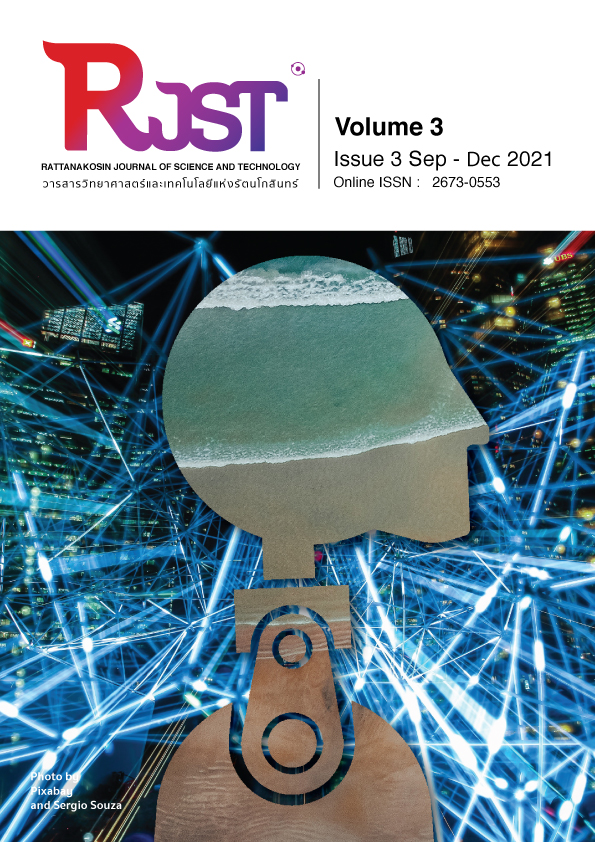อิทธิพลของการใช้เถ้าก้นเตาในปริมาณสูงเป็นวัสดุปอซโซลานต่อกำลังอัด การดูดซึมน้ำและการต้านทานแมกนีเซียมซัลเฟตของคอนกรีต
Main Article Content
บทคัดย่อ
บทความนี้นำเสนอผลกระทบของเถ้าก้นเตาปริมาณสูงในคอนกรีตเพื่อใช้เป็นวัสดุปอซโซลานต่อกำลังอัด การสูญเสียกำลังอัดเนื่องจากการแช่ในสารละลายแมกนีเซียมซัลเฟตและการดูดซึมน้ำของคอนกรีต เถ้าก้นเตาที่ใช้ในงานวิจัยถูกนำมาบดจนมีปริมาณอนุภาคค้างบนตะแกรงมาตรฐานเบอร์ 325 น้อยกว่าร้อยละ 5 โดยน้ำหนัก จากนั้นนำไปแทนที่ปูนซีเมนต์ร้อยละ 10, 20, 30, 50 และ 70 โดยน้ำหนักของวัสดุประสาน อัตราส่วนน้ำต่อวัสดุประสานเท่ากับ 0.45 ทดสอบกำลังอัดของคอนกรีตที่บ่มในน้ำประปาและน้ำที่มีสารละลายแมกนีเซียมซัลเฟตความเข้มข้นร้อยละ 5 ที่อายุการทดสอบ 7, 14, 28, 56 และ 90 วัน ในขณะที่การดูดซึมน้ำจะทดสอบที่อายุ 28 วัน ผลการทดสอบพบว่าคอนกรีตที่ใช้ปริมาณเถ้าก้นเตาร้อยละ 10 โดยน้ำหนักของวัสดุประสาน ให้ค่ากำลังอัดสูงกว่าคอนกรีตควบคุมและคอนกรีตที่ใช้ปริมาณเถ้าก้นเตาแทนที่ปูนซีเมนต์ ในส่วนผสมอื่นทุกอายุการทดสอบ ค่าร้อยละการสูญเสียกำลังอัดเมื่อแช่ในสารละลายแมกนีเซียมซัลเฟตของคอนกรีต มีค่าเพิ่มขึ้นเมื่ออายุมากขึ้น และร้อยละการสูญเสียกำลังอัดที่แช่ในสารละลายแมกนีเซียมซัลเฟตของคอนกรีตที่มีเถ้าก้นเตาปริมาณร้อยละ 50 และ 70 โดยน้ำหนักของวัสดุประสาน มีค่าสูงกว่าส่วนผสมอื่น ๆ สำหรับค่าการดูดซึมน้ำของคอนกรีต พบว่ามีค่าสูงขึ้นเมื่อคอนกรีตมีปริมาณเถ้าก้นเตาที่มากขึ้น นอกจากนี้ยังพบอีกว่าการสูญเสียกำลังอัดเนื่องจากการแช่ในสารละลายแมกนีเซียมซัลเฟต มีค่าเพิ่มขึ้นอย่างรวดเร็วเมื่อคอนกรีตมีค่าการดูดซึมน้ำมากกว่าร้อยละ 3.10 จากการวิจัยครั้งนี้ชี้ให้เห็นว่าถึงแม้การใช้เถ้าก้นเตาในปริมาณสูงในส่วนผสมคอนกรีตส่งผลให้มีค่ากำลังต่ำลง แต่กำลังอัดของคอนกรีตที่ได้ยังคงจัดเป็นคอนกรีตทนซัลเฟต ประเภท S0 ตามมาตรฐาน ACI 318-14
Article Details

อนุญาตภายใต้เงื่อนไข Creative Commons Attribution-NonCommercial-NoDerivatives 4.0 International License.
ข้อความภายในบทความที่ตีพิมพ์ในวารสารทั้งหมด รวมถึงรูปภาพประกอบ ตาราง เป็นลิขสิทธิ์ของมหาวิทยาลัยเทคโนโลยีราชมงคลรัตนโกสินทร์ การนำเนื้อหา ข้อความหรือข้อคิดเห็น รูปภาพ ตาราง ของบทความไปจัดพิมพ์เผยแพร่ในรูปแบบต่าง ๆ เพื่อใช้ประโยชน์ในเชิงพาณิชย์ ต้องได้รับอนุญาตจากกองบรรณาธิการวารสารอย่างเป็นลายลักษณ์อักษร
มหาวิทยาลัยฯ อนุญาตให้สามารถนำไฟล์บทความไปใช้ประโยชน์และเผยแพร่ต่อได้ โดยต้องแสดงที่มาจากวารสารและไม่ใช้เพื่อการค้า
ข้อความที่ปรากฏในบทความในวารสารเป็นความคิดเห็นส่วนตัวของผู้เขียนแต่ละท่านไม่เกี่ยวข้องกับราชวิทยาลัยจุฬาภรณ์ และบุคลากร คณาจารย์ท่านอื่น ๆ ในมหาวิทยาลัยฯแต่อย่างใด ความรับผิดชอบองค์ประกอบทั้งหมดของบทความแต่ละเรื่องเป็นของผู้เขียนแต่ละท่าน หากมีความผิดพลาดใด ๆ ผู้เขียนแต่ละท่านจะรับผิดชอบบทความของตนเอง ตลอดจนความรับผิดชอบด้านเนื้อหาและการตรวจร่างบทความเป็นของผู้เขียน ไม่เกี่ยวข้องกับกองบรรณาธิการ
เอกสารอ้างอิง
สำนักงานเศรษฐกิจอุตสาหกรรม, 2563, รายงานภาพรวมเศรษฐกิจและอุตสาหกรรมไทย ปี 2563 และแนวโน้ม ปี 2564, หน้า 26.
P. Chindaprasirt, C. Jaturapitakkul, W. Chalee and U. Rattanasak, “Comparative study on the characteristics of fly ash and bottom ash geopolymers,” Waste Manage., vol. 29, no. 2, pp. 539–543, 2009.
P. Krammart and S. Tangtermsirikul, “Properties of cement made by partially replacing cement raw materials with municipal solid waste ashes and calcium carbide waste”, Constr. Build. Mat., vol. 18, no. 8, pp. 579-583, 2004.
H. Kurama and M. Kaya, “Usage of coal combustion bottom ash in concrete mix-ture,” Constr. Build. Mat., vol. 22, no. 9, pp. 1922–1928, 2008.
W. Wongkeo, P. Thongsanitgarn, K. Pimraksa and A. Chaipanich, “Compressive strength, flexural strength and thermal conductivity of autoclaved concrete block made using bottom ash as cement replacement materials,” Mat. Des., vol. 35, pp. 434–439, 2012.
P. Khongpermgoson, A. Abdulmatin, W. Tangchirapat and C. Jaturapitakkul, “Evaluation of compressive strength and resistance of chloride ingress of concrete using a novel binder from ground coal bottom ash and ground calcium carbide residue,” Constr. Build. Mat., vol. 214, pp. 631–640, 2019.
กมล ตรีผอง, วีรพันธุ์ เจียมมีปรีชา และ อรรคเดช อับดุลมาติน. “การใช้ประโยชน์จากกากแคลเซียมคาร์ไบด์และเถ้าก้นเตาเป็นวัสดุประสานสำหรับคอนกรีตบล็อก,” วารสารวิศวกรรมศาสตร์ มหาวิทยาลัยศรีนครินทรวิโรฒ, ปีที่ 15 (ฉบับที่ 2), หน้าที่ 1–11, 2563.
C. Jaturapitakkul and R. Cheererot, “Deve-lopment of bottom ash as pozzolanic mat-erial,” J. Mat. Civ. Eng, ASCE, vol. 15, no. 1, pp. 48–53, 2003.
R. Siddique, “Compressive strength, water absorption, sorptivity, abrasion resistance and permeability of self-compacting concrete containing coal bottom ash”, Constr. Build. Mat., vol. 47, pp. 1444-1450, 2013.
A. Abdulmatin, W. Tangchirapat and C. Jaturapitakkulya, “An investigation of bot-tom ash as a pozzolanic material,” Constr. Build. Mat., vol. 186, pp. 155–162, 2018.
อรรคเดช อับดุลมาติน, วีรชาติ ตั้งจิรภัทร และ ชัย จาตุรพิทักษ์กุล. “ผลกระทบของชนิดของสารลดน้ำพิเศษต่อสมบัติของเพสต์และมอร์ตาร์ที่ใช้เถ้าก้นเตาร่วมกับกากแคลเซียมคาร์ไบด์เป็นวัสดุประสาน,”วารสารวิชาการสมาคมคอนกรีตแห่งประเทศไทย, ปีที่ 3 (ฉบับที่ 1), หน้าที่ 31–41, 2558.
ASTM C618, “Standard specification for coal fly ash and raw or calcined natural pozzolan for use in concrete,” ASTM International, West Conshohocken, PA, 2019.
ASTM C188-15, “Standard test method for density of hydraulic cement,” ASTM International, West Conshohocken, PA, 2015.
ASTM C39 / C39M-16, “Standard test method for compressive strength of cylindrical concrete specimens,” ASTM International, West Conshohocken, PA, 2016.
Kurama, H. and Kaya, M., 2008, "Usage of Coal Combustion Bottom Ash in Concrete Mixture," Construction and Building Materials, 22 (9) pp. 1922- 1928.
อรรคเดช อับดุลมาติน, ปกป้อง รัตนชู, เพ็ญพิชชา คงเพิ่มโกศล, วีรชาติ ตั้งจิรภัทร และ ชัย จาตุรพิทักษ์กุล. “การศึกษาปฏิกิริยาปอซโซลานของเถ้าก้นเตาที่ได้จากการเผาถ่านหินลิกไนต์และถ่านหินบิทูมินัส” วารสารวิจัยและพัฒนา มจธ., ปีที่ 43 (ฉบับที่ 1) หน้าที่ 49-65, 2563.
Bouzoubaa, N., Min-Hong Zhang, and V. M. Malhotra. "Mechanical properties and durability of concrete made with high-volume fly ash blended cements using a coarse fly ash." Cement and Concrete Research Vol 31, no. 10 : 1393-1402., 2001.
ACI Committee 318. “Building code requirements for structural concrete (ACI 318-11) and commentary. American Concrete Institute, Michigan. 519p (2015).
Baghabra Al-Amoudi, O.S., "Attack on Plain and Blended Cements Exposed to Aggressive Sulfate Environments", Cement and Concrete Composites, Vol. 24, No. 3–4, pp. 305-316. 2002.
Rasheeduzzafar, Al-Amoudi, O.S.B., Abduljauwad, S.N. and Maslehuddin, M., "Magnesium-Sodium Sulfate Attack in Plain and Blended Cements", Journal of Materials in Civil Engineering, Vol. 6, No. 2, pp. 201-222, 1994.
Jaturapitakkul, C., Kiattikomol, K., Tangchirapat, W. and Saeting, T., "Evaluation of the Sulfate Resistance of Concrete Containing Palm Oil Fuel Ash", Construction and Building Materials, Vol. 21, No. 7, pp. 1399-1405, 2007.


